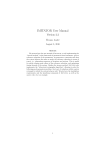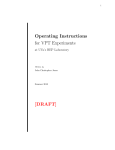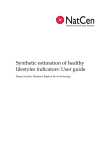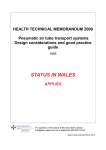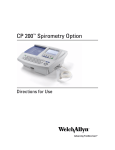Download HSE2010 Population number estimates user guide
Transcript
Health Survey for England 2010 Trend tables: Population number estimates 2 A survey carried out on behalf of The NHS Information Centre Joint Health Surveys Unit National Centre for Social Research Department of Epidemiology and Public Health, UCL Medical School Published by The NHS Information Centre for health and social care. The summary booklet and full text of this publication has been made available to you on the Internet at www.ic.nhs.uk/pubs/hse10report For queries about the report: Mail, telephone & e-mail The NHS Information Centre 1 Trevelyan Square, Boar Lane, Leeds LS1 6AE General enquiries: 0845 300 6016 E-mail: [email protected] NHS IC Responsible Statistician Paul Eastwood, Lifestyles Statistics Section Head Contact via [email protected], tel: 0845 300 6016 For hard copy requests: Mail, telephone & e-mail The Publications Officer National Centre for Social Research 35 Northampton Square, London EC1V 0AX Telephone orders/General enquiries: 020 7549 7006 E-mail: [email protected] All data from studies earlier than 2004 re-used with permission of the Department of Health. This work remains the sole and exclusive property of The Health and Social Care Information Centre and may only be reproduced where there is explicit reference to the ownership of The Health and Social Care Information Centre. This work may only be reproduced in a modified format with the express written permission of The NHS Information Centre. First published 15 December 2011. Designed by Davenport Associates Copyright © 2011, The Health and Social Care Information Centre. All rights reserved Copyright © 2011, The Health and Social Care Information Centre. All rights reserved. Health Survey for England – 2010 trend tables: Population number estimates User Guide Tables Contents Years available 1 Adults: number estimates for body mass index (BMI) categories, by survey year, age and sex 2003-2010 2 Adults: number estimates for self-reported cigarette smoking status, by survey year, age and sex 2003-2010 3 Adults: number estimates for alcohol consumption on heaviest drinking day in the last week, by survey year, age and sex 2003-2010 4 Adults: number estimates for fruit and vegetable consumption, by survey year, age and sex 2003-2010 5 Adults: number estimates for levels of physical activity, by survey year, age and sex 2003, 2004, 2006, 2008 6 Children: number estimates for overweight and obesity prevalence, by survey year and sex 2003-2010 7 Children: number estimates for fruit and vegetable consumption, by survey year, age and sex 2003-2010 8 Children: number estimates for levels of physical activity, by survey year, age and sex 2006, 2007 9 ONS mid-year population estimates for adults aged 16 and over living in private households 2003-2010 10 ONS mid-year population estimates for children aged 2-15 2003-2010 Adults Children Copyright © 2011, The Health and Social Care Information Centre. All rights reserved Bases HSE 2010: | TREND TABLES: POPULATION NUMBER ESTIMATES 1 Introduction Background The Health Survey for England (HSE) is a series of annual surveys designed to measure health and health-related behaviours in adults and children living in private households in England. The survey was commissioned originally by the Department of Health, and from April 2005 by The NHS Information Centre for health and social care. Since 1994, the survey has been carried out by the National Centre for Social Research and the Department of Epidemiology at the University College London (UCL) Medical School. The survey consists of an interview and nurse visit. There is a series of core elements that are included every year and special topics that are included in selected years. Core topics include general health, smoking, drinking, fruit and vegetable consumption, height, weight, blood pressure measurements and blood, urine and saliva samples. Special topics include, for example, cardiovascular disease, physical activity, accidents, lung function measurement and certain blood analytes; in 2010 the main focus was respiratory health and lung function, and questions were also included covering contraception and sexual health, well-being, kidney disease and dental health. Each year there is a general population sample in which adults and children in selected households are eligible for inclusion. Adults aged 16 and over have been included since the start of the HSE series, children aged 2-15 were first included in 1995, and infants aged 0-1 have been included since 2000. In some years the size of the general population sample is reduced and a boost sample used to increase the proportion of respondents from certain population groups, such as in 2002 when a boost sample of children and young adults was included, and 2005 when a boost of older people aged 65 and over was included. In 2010, there was a general population sample of around 8,000 adults and 2,000 children, and an additional boost sample of around 3,600 children aged 2-15. The trend tables focus on key changes in core topics and measurements. • The number estimates presented here convert the prevalences in the key trend tables into estimates of the numbers of people in the population in England that they represent. As an illustration, the obesity prevalence estimate of 26.1% for all adults aged 16 and over in 2010 has been converted into a number estimate of around 11.0 million (between 10,467,000 and 11,517,000). The tables in this series relate to lifestyle characteristics influencing health: overweight and obesity, fruit and vegetable consumption, smoking, drinking and physical activity. The number estimates cover 2003-2010. Estimates for adult physical activity, however, are only available for 2003, 2004, 2006 and 2008, and child physical activity for 2006 and 2007. The prevalence trend tables present the results from the representative general population sample, and in some years boost sample data are also included to increase the precision of sub-group estimates (e.g. young adults in 2002, persons aged 65 and over in 2005). For the number estimates, the prevalence estimates for each year (expressed as a proportion) were multiplied by a scaling factor equal to the total mid-year population estimate published by the Office for National Statistics multiplied by the estimated proportion of people in the relevant age-sex group in the HSE. The mid-year population estimate published by the Office for National Statistics (ONS)1 was adjusted to represent the population living in private households, excluding those aged 65 years and over living in institutions (42.1 million adults aged 16 and over in 2010). Details of the method used to compute the number estimates and accompanying margin of 2 HSE 2010: | TREND TABLES: POPULATION NUMBER ESTIMATES Copyright © 2011, The Health and Social Care Information Centre. All rights reserved • The trend tables, updated each year, show survey estimates of prevalence (the percentage of the population overweight, obese, current smokers etc) for a number of key measures. The 2010 trend tables are available at www.ic.nhs.uk/pubs/hse10trends. error (i.e. the width of the 95% confidence interval divided by two) are provided in the technical annex. How to use these tables The eight tables presented here show estimates of how many people in England, living in private households, have particular characteristics or behaviour. For instance the tables show the number of men and women who are estimated to be obese, who eat the recommended five or more portions of fruit and vegetables a day, or who currently smoke cigarettes. The tables also show breakdowns by age groups, for instance the number of children aged 11 who meet the government’s recommendation of eating five or more portions of fruit and vegetables per day, or the number of 16-24 year olds who drink above recommended levels of alcohol. Each table for adults shows results separately for men and women, usually within age categories, followed by results for all adults (men and women combined). Similarly tables for children show results for boys and girls within age groups, and then results for all children. • Numbers in all tables are presented in thousands, so 10,301 in the tables represents an estimate of 10,301,000 people in the population in England. • As results are based on survey data they are affected by sampling error. The margin of error is shown for each estimate in the tables, again in thousands. For instance ‘± 389’ in the tables represents ± 389,000. The lower and upper limits of the 95% confidence interval can be obtained from the margin of error as follows: Upper limit = estimate + margin of error Lower limit = estimate – margin of error • The confidence interval shows the range within which the true result is likely to fall (at the 95% confidence level). Thus for the estimate of 10,301,000 people and a margin of error of ± 389,000, the true value is expected to lie between 9,912,000 and 10,690,000 in 95 cases out of 100. Copyright © 2011, The Health and Social Care Information Centre. All rights reserved • The confidence interval is a measure of the survey’s reliability, and is also influenced by the size of the sample. For a large sample such as all men or all women, the confidence interval is narrow. Where the sample size is smaller, for instance when looking at a particular age group, the confidence intervals are larger (reflecting the larger uncertainty in the estimation). Estimates for adults aged 16 and over based on a full-size general population sample of 15,000-16,000 adults (2003, 2006 and 2008) have a narrower confidence interval than in years with smaller samples (2004, 2005, 2007, 2009 and 2010). • The ONS mid-year population estimate bases for 2003-2010 are shown in Tables 9 and 10 for adults and children respectively. It should be noted that there may be slight differences between the sum of estimates in the tables and the bases in the final two tables. (For instance the sum of the % low, % medium and % high levels of physical activity may not sum to the exact population size). The reason for this is the rounding of estimates to the nearest thousand. • Before 2003, no weighting was applied to the adult sample, whereas from 2003 survey estimates have been weighted for non-response.2 The sample of children each year was weighted to adjust for the probabilities of selection,3 and from 2003 non-response weighting was also introduced for children. While the prevalence tables show estimates from 1993 onwards, the number estimates series are published from 2003 onwards. Number estimates before 2003 are not shown because the change in weighting means a different calculation must be used for the confidence intervals, as described in the technical annex. • Non-response weighting brings the profile of the survey sample very close to the profile of the total population; however, at the time that weighting is applied the ONS mid-year HSE 2010: | TREND TABLES: POPULATION NUMBER ESTIMATES 3 population estimates for the relevant year are not available, and the previous year’s population estimates are used. Estimates for the 2010 prevalence trends, therefore, have been computed on a non-response weight based on 2009 mid-year population estimates. The 2010 number estimates have been computed using a grossing-up factor calculated from the ONS 2009 mid-year population estimates. • The population of England living in private households has increased from around 39.7 million in 2003 to 42.1 million in 2010. Therefore an increase in numbers in a particular category from one year to the next is not unexpected. Increases in the numbers should be considered alongside any change in prevalence (i.e. the percentage of the population) for that category. For full details on key trends in the health of adults and children since 1993 on selected topics see the commentary for the prevalence trend tables at www.ic.nhs.uk/pubs/hse10trends. Technical annex This section provides a technical description of the methods used to calculate the number estimates and accompanying margins of error. The section concludes with a worked example. The method used is valid only from the introduction of non-response weighting into the HSE series. The number estimates, therefore, are presented for years 2003 onwards. For each indicator the data presented in the prevalence trend tables were multiplied by a scaling factor to estimate the number of people with particular characteristics or behaviour (number obese, number of current smokers etc). The scaling factor was based on two figures. The first was the ONS mid-year population estimate for the relevant year, adjusted to represent the population living in private households (i.e. excluding those aged 65 years and over living in institutions). The second figure used was an estimate of the proportion of people in the relevant age-sex group (e.g. percentage of the adult population who were male aged 16-24). The proportions in each age-sex group were calculated from HSE data (with the non-response weight applied). It should be noted that a different estimate of this second figure is calculated for each table as only the respondents to the relevant question are included in the calculation. This means that the age-sex distribution estimated from HSE data does not correspond exactly to the age-sex distribution available from the ONS figures.4 The calculation chosen allows the prevalence estimates to be re-created from the number estimate tables. The weighting variable can be denoted as wij where i denotes the age-sex group of the HSE respondent (e.g. men aged 16-24) and j denotes the HSE respondents to the question within each age-sex group. Then the weighted number of respondents to the question can be expressed as: w = ∑wi j [1] i ,j and the weighted number of respondents of a particular age-sex group as: wi = ∑wi j [2] j Dividing [2] by [1], therefore, gives the estimate of the proportion of the population belonging to a particular age-sex group. 4 HSE 2010: | TREND TABLES: POPULATION NUMBER ESTIMATES Copyright © 2011, The Health and Social Care Information Centre. All rights reserved I Number estimates If the overall (i.e. men and women combined) ONS mid-year population estimate is labelled as P, then the HSE estimate of the number of persons belonging to age-sex group i (labelled Mi) can be expressed as: wi Mi = P w [3] ( ) This is the scaling factor described above: the ONS mid-year population total (P) multiplied by the estimate of the proportion of people in the relevant age-sex group. Note that due to item non-response (e.g. refusals and don’t knows) the proportion will be slightly different for each table. Finally, if the number estimate for age-sex group i and health lifestyle indicator k is labelled Nik, and the corresponding prevalence estimate is labelled φi k, then the number estimate can be derived as follows: w Nik = P wi φi k [4] In other words, the estimated number of, say, obese men aged 16-24, can be expressed as the overall ONS population estimate P, multiplied by the proportion of respondents with a valid BMI who were male aged 16-24, multiplied by the estimated obesity prevalence for men aged 16-24. Using this calculation method allows the estimates in the prevalence trend tables to be reproduced from the number estimates, ensuring consistency between the two sets of tables. Take care to note, therefore, that the only ONS mid-year population estimate that can be reproduced from these figures is the overall population figure, P (i.e. total population aged 16 and over in the relevant year). The proportion of people in the relevant age-sex group is taken from the HSE (and not ONS) data. The implication of this is that the prevalence estimates cannot (and should not) be derived by dividing the number estimate for each age-sex group by the corresponding ONS agesex population estimate.4 For prevalence estimates users are advised to consult the prevalence trend tables. II Margin of error Copyright © 2011, The Health and Social Care Information Centre. All rights reserved The margin of error (MoE) of the number estimates is calculated by multiplying the MoE of the prevalence by Mi: the scaling factor used to create the number estimates. If Eik is the margin of error for a number estimate and Ɛik is the margin of error of the associated prevalence then: Pwi Ɛ i k [5] Eik = The standard error of the prevalence is calculated using STATA’s survey module commands which take into account the complex sample design. The MoE is then calculated by multiplying the standard error by 1.96. In order to use equation 5, it must be assumed that no further uncertainty is added to the number estimate when the prevalence is multiplied by the scaling factor, in other words that w the scaling factor P wi is constant. It is assumed that the ONS estimates P have small enough variance to discount. w The same assumption can be made for the factor wi . This assumption is justified by w considering that wi is the weighted proportion of respondents for a particular age-sex group. The purpose of the weighting is to correct the figures for non-response. The weighting scheme uses several variables including age and sex. The weighting is chosen to w make wi approximately equal to a fixed value, taken from the ONS population estimates. That is, although the age-sex distribution of the sample is prone to sampling error, the w weighting ‘fixes’ the values of wi to be approximately equal to the ONS population estimates. HSE 2010: | TREND TABLES: POPULATION NUMBER ESTIMATES 5 It should be noted that the variance of wi is not exactly zero. Due to the impact of other w w variables included in the weighting and differential item non-response4 the value of wi is not exactly the same for all possible samples. This means the assumption causes a slight underestimate in the value of the margins of error. However, the variation is small and the assumption allows considerable computational efficiency gains. Worked example The method used to convert the prevalence estimates in some of the standard trend tables into estimates of the numbers of people in the population in England that they represent is illustrated here using a worked example. The example used is obesity (including morbidly obese) for men using HSE 2007. Table A1 shows the calculation of the number estimates; Table A1 2007 number estimates (obesity for men) Age group ONS population estimate (P) Prevalence of obesity (φi k) Weighted number of respondents (w) Weighted number of respondents of age-sex group (wi) HSE number estimate age-sex group (Mi) Estimated number obese (Nik) 16-24 25-34 35-44 45-54 55-64 65-74 75+ Column 1 41,034,273 41,034,273 41,034,273 41,034,273 41,034,273 41,034,273 41,034,273 2 0.091 0.156 0.248 0.345 0.309 0.284 0.219 3 5,991 5,991 5,991 5,991 5,991 5,991 5,991 4 461 499 603 514 446 296 189 5 3,156,621 3,421,061 4,127,411 3,523,963 3,057,682 2,024,746 1,292,632 6 287,181 534,096 1,025,474 1,216,872 946,352 574,557 283,495 Table A2 the calculation of the margin of error. • Column 1 shows the overall ONS population estimate for adults: showing just over 41 million adults aged 16 and over living in private households in England on 30th June 2007. • Column 3 shows the weighted number of HSE respondents with a valid BMI measurement (using the non-response main interview weight, which is scaled to the achieved sample size, resulting in the weight being standardised around an average of one). • Column 4 shows the weighted number of HSE respondents in each age-sex group. Of all HSE 2007 respondents aged 16 and over (with valid BMI), about 7.7% were men aged 1624 (column 4/column 3). • Column 5 shows that applying the proportion of HSE respondents in each age-sex group to the ONS population estimate P gives an HSE estimate of the number of persons in the population in each age-sex group: equation [3] above. Applying the proportion of HSE respondents who were male aged 16-24 (461/5,991 = 0.077) to the ONS population estimate gives an estimated number of 3,156,621 men aged 16-24: HSE estimatemen,16-24 = 41,034,273 6 461 ( 5,991 ) = 3,156,621 HSE 2010: | TREND TABLES: POPULATION NUMBER ESTIMATES Copyright © 2011, The Health and Social Care Information Centre. All rights reserved • Column 2 shows the estimated prevalence of obesity for each of the seven age groups (expressed as a proportion). 21.9% of men aged 75+ were classed as obese, compared with 9.1% of men aged 16-24. • Column 6 shows the number estimate of men in England who were classed as obese in 2007: which can be calculated using equation [4]. As an illustration, for men aged 16-24, the estimate of the number who were obese can be calculated as follows: obesemen,16-24 = 41,034,273 461 ( 5,991 ) 0.0910 = 287,181 (rounded to 287,000) The number in the population estimated to be obese can be expressed as the prevalence (0.091 for men aged 16-24) multiplied by a scaling factor equal to the ONS mid-year population estimate (41 million) multiplied by the HSE estimate of the proportion of people in the male 16-24 category (461/5,991 = 0.077). Table A2 Estimated margin of error Age group 16-24 25-34 35-44 45-54 55-64 65-74 75+ Prevalence of obesity (φi k) Column 1 0.091 0.156 0.248 0.345 0.309 0.284 0.219 Estimated standard error (SE) HSE number estimate age-sex group (Mi) 2 0.017 0.019 0.019 0.022 0.022 0.023 0.026 3 3,156,621 3,421,061 4,127,411 3,523,963 3,057,682 2,024,746 1,292,632 Standard Margin error of of error estimated (unrounded) number obese 4 53,756 66,225 80,382 78,154 68,246 45,951 32,999 5 105,362 129,801 157,549 153,181 133,763 90,064 64,677 Note, therefore, that the HSE estimate of the proportion of the population in England in each age-sex group does not match exactly the equivalent ONS mid-year estimate (see endnote 4). The only ONS mid-year population estimate that can be reproduced is the overall population figure. • Columns 1 and 2 show the estimated prevalence of obesity and accompanying standard error (SE) respectively (both expressed as a proportion). • Column 3 shows the HSE estimate of the number of residents in England in each age-sex group (described above). Copyright © 2011, The Health and Social Care Information Centre. All rights reserved • Column 4 shows the SE of the estimated number that were obese. It is calculated by multiplying the SE of the prevalence by the estimated number of people in the relevant age-sex group (column 2 × column 3). For men aged 16-24, the estimated SE of the number who were obese can be calculated as follows: SE number obesemen,16-24 = 0.017 x 3,156, 621 = 53,756 • Column 5 gives the margin of error (MoE): the estimated SE of the number estimate multiplied by 1.96. For men aged 16-24 the MoE is as follows: MoE number obesemen,16-24 = 53,756 x 1.96 = 105,362 (rounded to ± 105,000). HSE 2010: | TREND TABLES: POPULATION NUMBER ESTIMATES 7 References and notes 1 ONS mid-year population estimates are available at www.ons.gov.uk/ons/search/index.html?newquery=2009+mid+year+estimates 2 Sproston K and Primatesta P (eds). Health Survey for England 2003: Volume 3 Methodology and documentation. The Stationery Office, London, 2004. 3 Only up to two children per household are interviewed, and in households with three or more children, two are selected at random. Therefore weighting is required to ensure that children in larger households are not under-represented in the sample. The non-response weighted estimates from 2003 onwards include the necessary adjustment for child selection. 4 The weighted age-sex distribution of HSE respondents does not exactly match the corresponding distribution available from the ONS mid-year population estimates. There are two reasons for this. First, at the time that weighting is applied the mid-year population estimates for the relevant year are not available, and the previous year’s population estimates are used. Second, the healthy lifestyle indicators are subject to item non-response. For example, the BMI categories are based on respondents with a valid height and weight measurement. There is some non-response among interviewed respondents to height and weight measurements, and the weighting applied to interview data does not correct for this element of non-response. The age profile for the achieved samples in 2003, 2006 and 2007 are shown below, compared with the ONS population estimates for 2007 (adjusted for institutional populations), shown in the shaded column. It can be seen that those in the youngest and oldest categories tend to be slightly under-represented, and this should be borne in mind in interpreting the data. ONS and HSE age-profiles HSE 2007 2003 2006 2007 % % % % 16-24 15.00 15.46 14.86 14.45 25-34 16.25 16.79 15.99 16.12 35-44 18.99 19.40 20.30 20.05 45-54 16.17 16.18 16.45 16.88 55-64 14.68 14.67 14.91 15.00 65-74 10.11 9.92 10.22 10.15 8.79 7.58 7.28 7.35 75+ 8 ONS HSE 2010: | TREND TABLES: POPULATION NUMBER ESTIMATES Copyright © 2011, The Health and Social Care Information Centre. All rights reserved Age group National Centre for Social Research www.natcen.ac.uk The National Centre for Social Research is the largest independent social research institute in Britain, specialising in social survey and qualitative research for the development and evaluation of policy. NatCen specialises in research in public policy fields such as health, housing, employment, crime, education and political and social attitudes. Projects include ad hoc and continuous surveys, using face-to-face, telephone, online and postal methods; many use advanced applications of computer assisted interviewing. NatCen has approximately 275 staff, a national panel of over 1,000 interviewers, and 150 nurses who work on health-related surveys. Research Department of Epidemiology and Public Health, UCL Medical School www.ucl.ac.uk/epidemiology The Research Department of Epidemiology and Public Health, chaired by Professor Richard Watt, is a leading centre for research into the social determinants of health. The department has a strong interdisciplinary structure. The Department houses over 180 staff in 13 main research groups, including the Joint Health Surveys Unit, part of the Health and Social Surveys Research Group. Collaborative research is conducted through the International Institute for Society and Health and across the Division. The Department's research programme is concerned particularly with social factors in health and illness and inequalities in these, including national cross-sectional surveys of health and behaviour (such as diet), longitudinal studies of cardiovascular disease (Whitehall studies) and the English Longitudinal Study of Ageing (ELSA); international studies of cardiovascular disease and diabetes; socio-dental indicators of need; and the socio-economic and policy implications of an ageing population.












